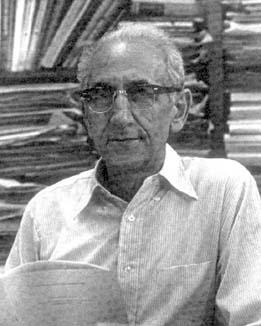


 تاريخ الرياضيات
تاريخ الرياضيات
 الرياضيات في الحضارات المختلفة
الرياضيات في الحضارات المختلفة 
 الرياضيات المتقطعة
الرياضيات المتقطعة
 الجبر
الجبر
 الهندسة
الهندسة 
 المعادلات التفاضلية و التكاملية
المعادلات التفاضلية و التكاملية 
 التحليل
التحليل
 علماء الرياضيات
علماء الرياضيات |
Read More
Date: 23-10-2017
Date: 25-10-2017
Date: 3-11-2017
|
Died: 17 September 1999 in Pittsburgh, Pennsylvania , USA

Leonard Carlitz' father was a Ukrainian while his mother was a Latvian. They were a Jewish family who emigrated with Leonard's four grandparents to the United States around 1890. Leonard attended school in Philadelphia and his remarkable academic talents were clear at this time. These talents led to him being awarded a scholarship to study mathematics at the University of Pennsylvania in Philadelphia. He graduated with a A.B. in mathematics in 1927, completing his Master's degree in mathematics the following year.
On completing his Master's degree, Carlitz remained at the University of Pennsylvania to study for his doctorate which was supervised by H H Mitchell (a student of Veblen). He became interested in Artin's early work which was on quadratic number fields, in particular the analytic and arithmetic theory. In 1927 Artin made a major contribution to the theory of noncommutative rings, called hypercomplex numbers at this time. Inspired by Artin's work, Carlitz wrote his dissertation Galois fields of certain types which led to the award of a doctorate in 1930. The main results of his doctoral dissertation were published in theTransactions of the American Mathematical Society in the year that his doctorate was awarded.
Immediately after the award of his doctorate, Carlitz received a National Research Council Fellowship which let him spend a year at the California Institute of Technology working with E T Bell. Returning to Philadelphia in the summer of 1931, he married Clara Skaler. They would have two sons Michael Carlitz, born in 1939, and Robert Carlitz born in 1945.
After his marriage Carlitz and his wife headed for Cambridge in England where he spent the academic year 1931-32 as an International Research Fellow with G H Hardy. When he returned to the United States he was offered a post at Duke University which he accepted. Carlitz remained on the Faculty at Duke from his appointment in 1932 until he retired in 1977. He was named James B Duke Professor of Mathematics.
Carlitz published 771 papers, supervised 44 doctoral and 51 master's theses. His major mathematical contributions are to finite field theory, number theory, and combinatorics. But his publications extend beyond these areas to include algebraic geometry, commutative rings and algebras, finite differences, geometry, linear algebra, and special functions. As Brawley writes in [1]:-
Leonard Carlitz is certainly one of the most prolific mathematical researchers of all time.
John Brillhart is the editor-in-chief of Carlitz's Collected Works and, given Carlitz's remarkable publication record, few editors of such volumes will have to handle a larger number of papers and the final result should contain around 6800 pages of research articles.
Hayes describes in [2] a graduate course that Carlitz gave at Duke University:-
While a graduate student at Duke University in the early 1960s, I was privileged to take Leonard Carlitz course "The arithmetic of polynomials." At the first class meeting, Leonard gave each student a detailed set of notes that served as a textbook for the course. These notes were neatly typed and reproduced by ditto machine, the leading-edge copying technique of that era. My own copy, still readable in faded ditto purple, occupies a special place on my office bookshelf. Of course the notes evolved over time. The version I have is 277 pages long and divided into 29 chapters.
One chapter of these chapters, Chapter 19, is published as an article in Finite Fields Appl. 1 (2) (1995), a volume specially dedicated to Carlitz. Mullen, the editor-in-chief, writes in the introduction to the part:-
With his permission, this article was extracted from classroom notes Carlitz wrote some forty to fifty years ago and shows that there is significance even in his unpublished research.
Mullen, a doctoral student at the time, writes in [3] of meeting Carlitz:-
During the 1973-74 academic year, Professor Leonard Carlitz gave a colloquium in our department concerning permutation polynomials over finite fields. ... I vividly recall the tremendous enthusiasm that Professor Carlitz showed for various topics in finite field theory. In addition I recall how generous Professor Carlitz was with his ideas. Shortly after his return to Duke University, Professor Carlitz sent me a large package of reprints along with a number of very helpful comments and references.
Carlitz's contribution is summed up in [1]:-
Leonard Carlitz, a kind and gentle man with deep mathematical insights, has left a truly remarkable research record ...
Articles:



|
|
|
|
التوتر والسرطان.. علماء يحذرون من "صلة خطيرة"
|
|
|
|
|
|
|
مرآة السيارة: مدى دقة عكسها للصورة الصحيحة
|
|
|
|
|
|
|
نحو شراكة وطنية متكاملة.. الأمين العام للعتبة الحسينية يبحث مع وكيل وزارة الخارجية آفاق التعاون المؤسسي
|
|
|